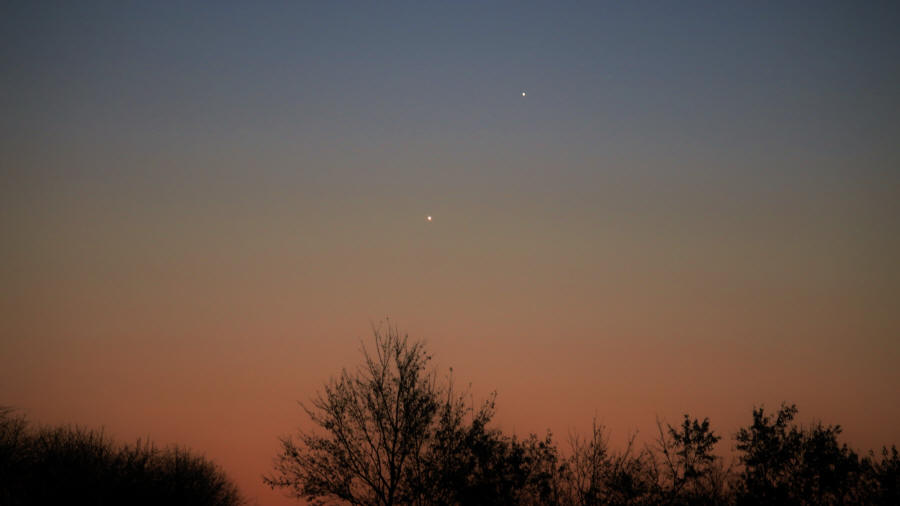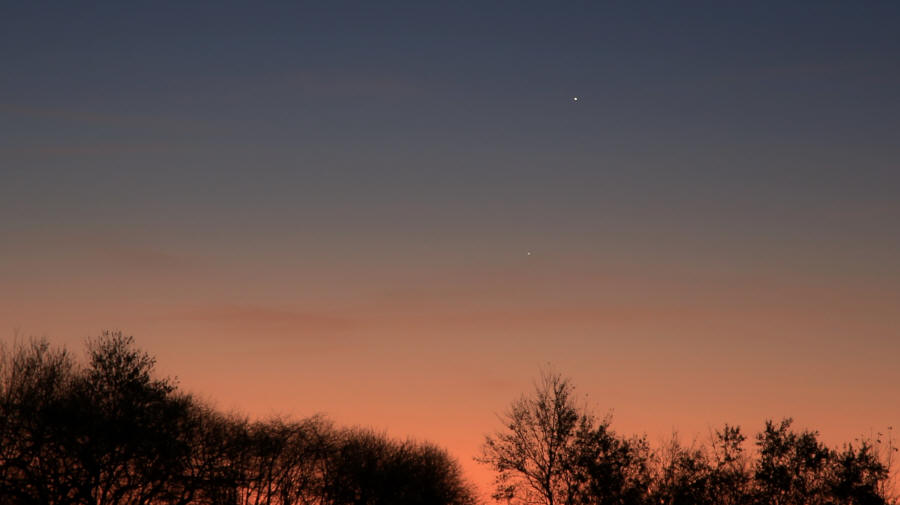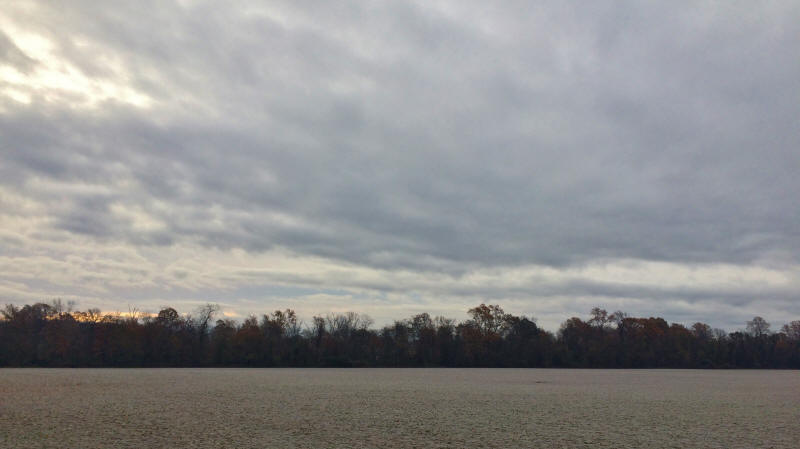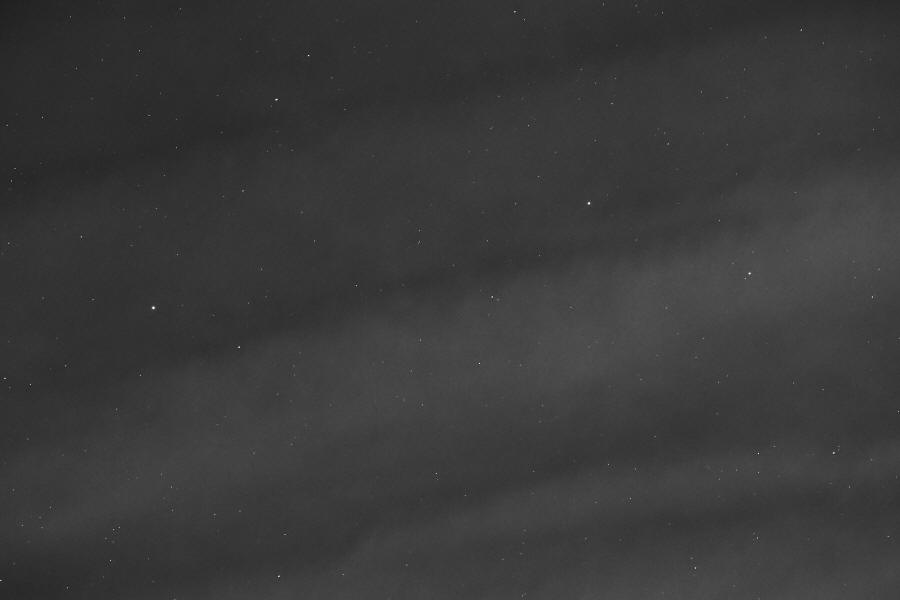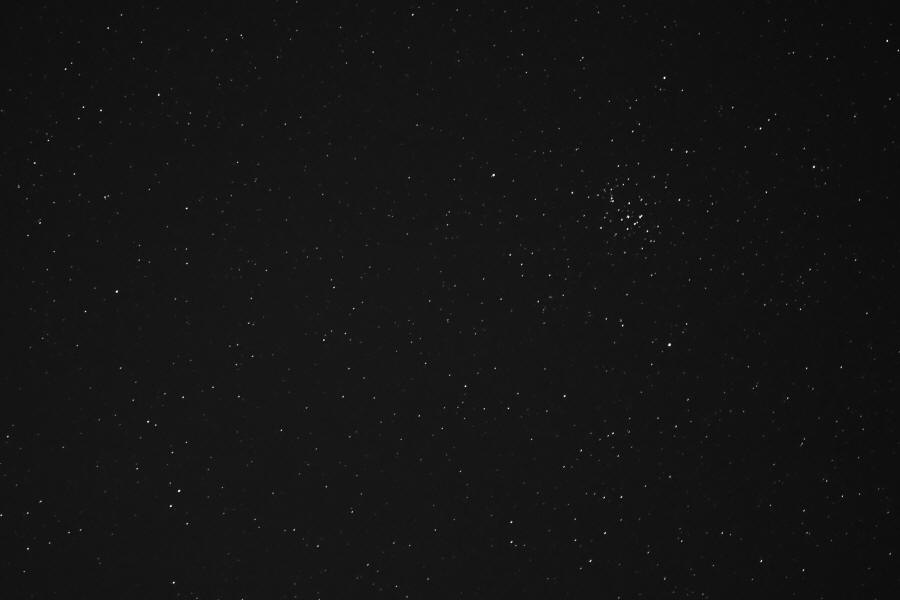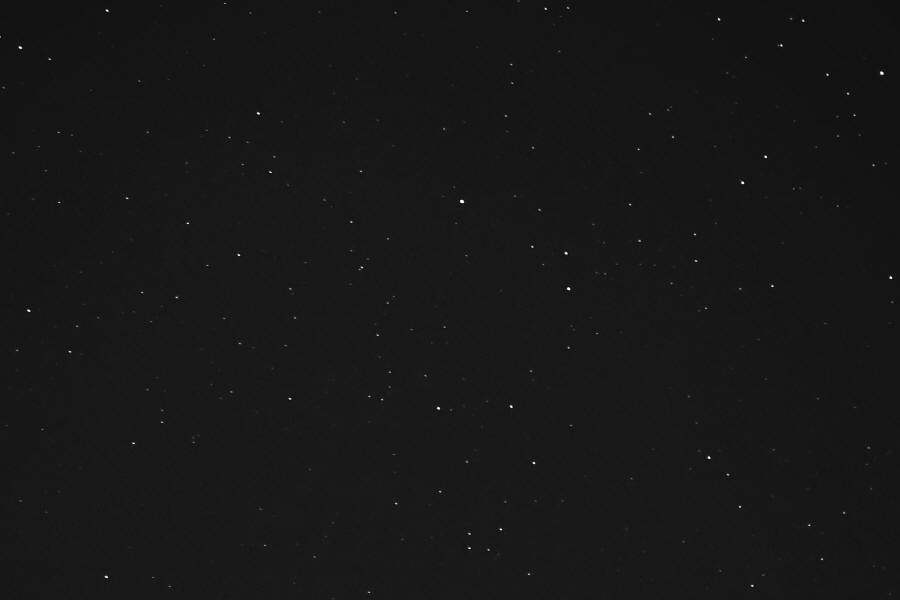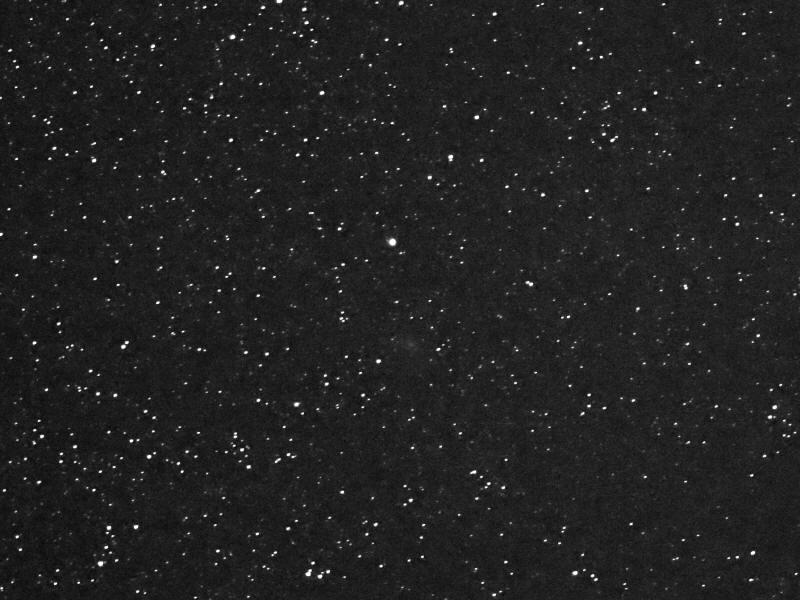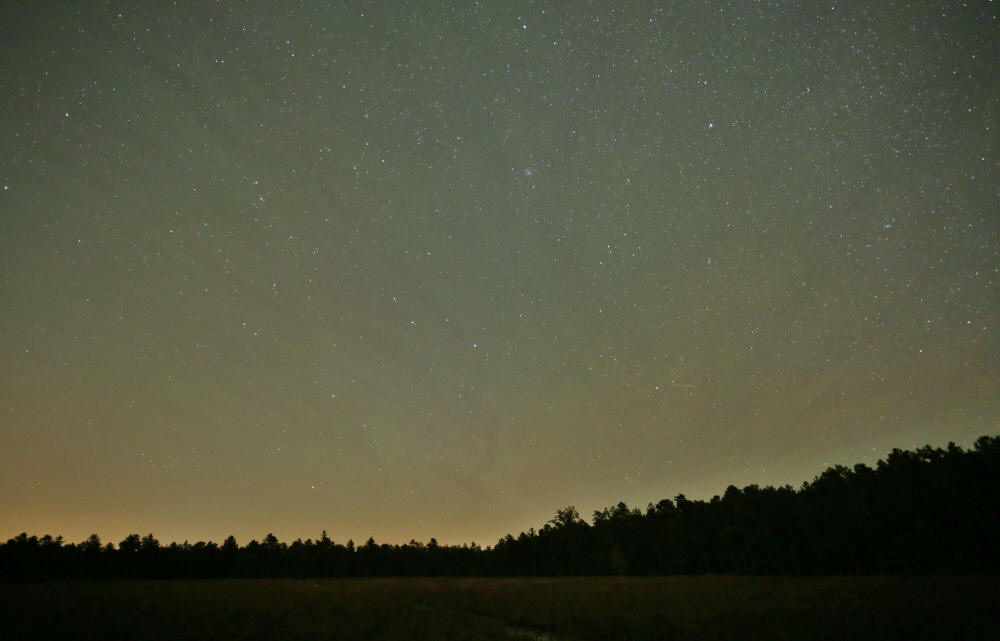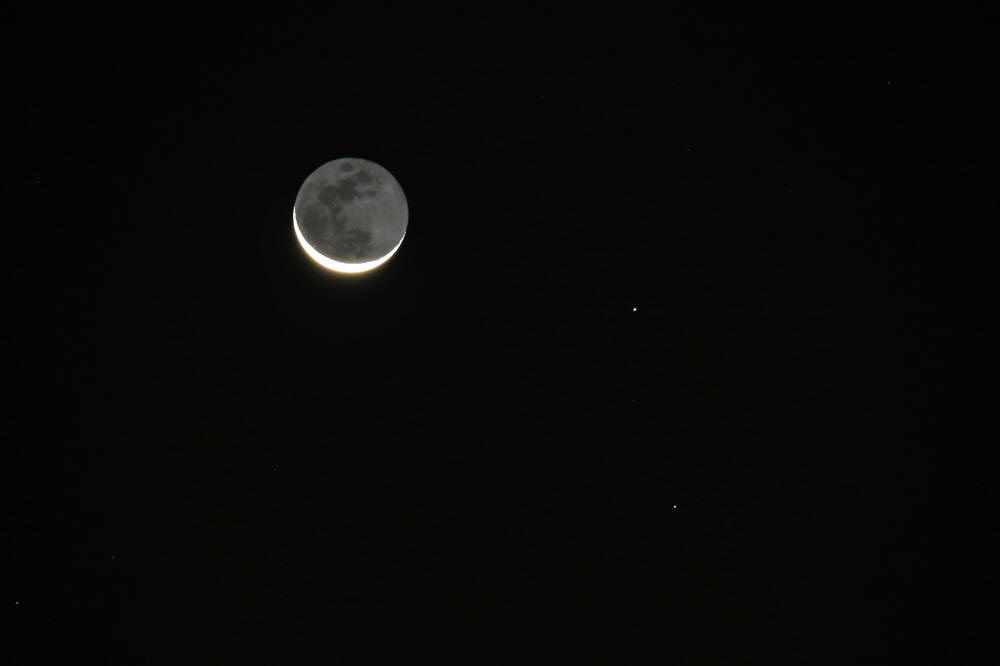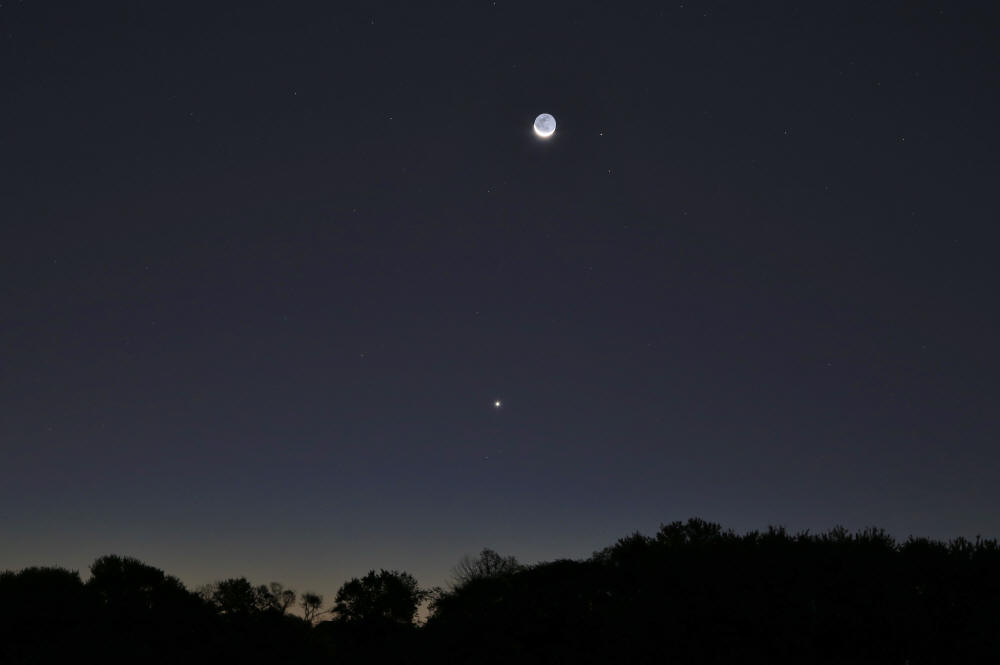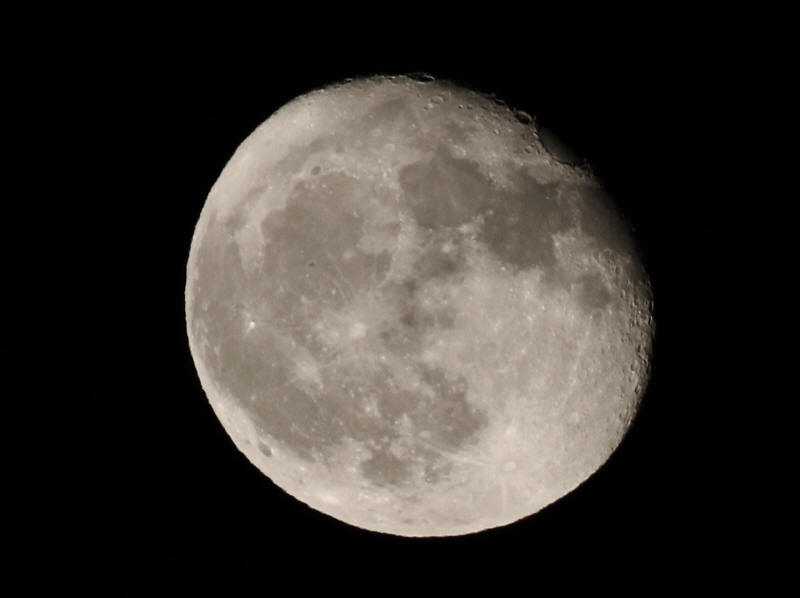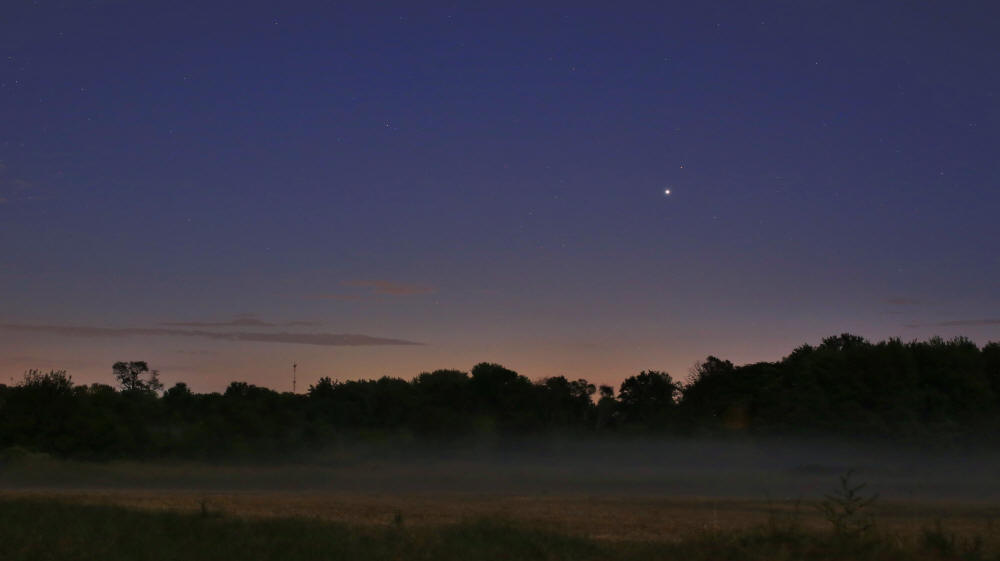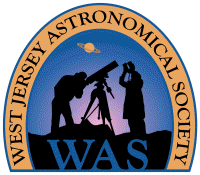Venus and Jupiter
November 14, 2017
On the morning of November 14, 2017, I went back to Swede Run in Moorestown, NJ, to observe the ongoing movement of Venus relative to Jupiter, three days since the last observation on November 11 pictured below. Clouds precluded observing them on the 12th, and again on the 13th when they were closest to each other (about 17 arc minutes apart). This picture of them was captured at 6:00 am EST on November 14. It was taken with a Canon 6D digital SLR camera and a Tamron 150 to 600 mm f/5-6.3 zoom lens (on a fixed tripod) set to 300 mm focal length, then cropped vertically to a 16:9 ratio, yielding a field 6.8° wide x 3.8° high. It was exposed 1/5 second at f/5.6, ISO 1600, with daylight white balance (mouseover for labels and positional information).
Currently, both planets are moving east with respect to the background stars, Venus at 1.25°/day and Jupiter at 0.22°/day. Since the Sun is now moving east at 1.01°/day, Venus is getting lower in morning twilight as it approaches superior conjunction on January 9, 2018. Jupiter is rising higher in the morning sky and will reach opposition on May 8, 2018.
Venus and Jupiter
November 11, 2017
On the morning of November 11, 2017, I went to Swede Run in Moorestown, NJ, to look for several things. First, the asteroid (4) Vesta, before or during the early stages of astronomical twilight (which would begin at 5:08 am EST). Second, an International Space Station (ISS) pass. Third, the close pairing of the planets Venus and Jupiter before sunrise at 6:41 am, and the grand finale, the 7:37 am launch out of Wallops Island, VA, of an Antares rocket carrying the Cygnus spacecraft on the OA-8 mission to resupply the ISS.
I arrived about 5 am, and shortly after, started to look for Vesta with my handheld 15x56 binoculars, starting at Spica (in Virgo) and moving left 8° across 76 and 82 Virginis until I found a couple pairs of seventh-magnitude reference stars near Vesta. However, they were only about 5° altitude at the time, so magnitude 7.9 Vesta just wasn't visible. Ultimately, by 5:30 am when they were up to about 9° altitude, and I mounted the binoculars on a monopod, I was able to glimpse Vesta.
In the meantime, I was looking in the north-northwest around 5:21 am to see the ISS emerge from the earth's shadow in Cepheus as predicted by Heavens-Above. It would reach magnitude -1.4 on this pass. Just before the ISS emerged, I caught a glimpse of another satellite in my peripheral vision, but I stayed focused on the ISS area and saw it appear in "mid air" at 11° altitude. I then looked up and saw the other satellite (first magnitude at the time, much brighter than the H-A prediction) passing through Perseus. H-A indicated it was a spent Chinese CZ-4B rocket booster (Chang-Zheng = Long March).
Venus was first noted, with unaided eyes, above the treetops at 5:45 am when I looked up from writing my notes, so perhaps it would have been visible if I had looked a few minutes sooner (Venus rose at 5:27 am). At 5:47 am, I saw Jupiter through gaps in the trees with the 15x56s (Jupiter rose at 5:38 am). I continued to watch Venus and Jupiter with unaided eyes as they climbed higher in the brightening twilight. They were nominally 2° apart, although they didn't seem that close. I suspect the "moon illusion" caused the space between them to look greater than it actually was. At 6:15 am, it was becoming difficult to see Jupiter with unaided eyes, but Venus remained visible with unaided eyes at least until sunrise at 6:41 am.
Using Venus as a guide, Jupiter was visible as a ghostly disc in the binoculars through sunrise. Currently, Venus is about magnitude -3.9, which is almost 8x brighter than Jupiter at about magnitude -1.7, but given the nominal diameters of Venus (10 arc seconds) and Jupiter (30 arc seconds), Venus has a surface brightness of 0.84 magnitudes per square arc second, which is almost 70x brighter than Jupiter at 5.4 mag/sq arc sec, hence Jupiter's comparatively ghost-like appearance in a bright sky compared to brilliant Venus.
Venus and Jupiter will make their closest approach (appulse) for 40°N-75°W on Monday morning, November 13, at 3:23 am when they'll be 15' 42" apart. However, that's more than a couple of hours before they rise. At 6 am when they clear the treetops, they'll be about 17 arc minutes apart.
The picture above shows Venus and Jupiter at 6:05 am on November 11 (mouseover for labels and positional information). It was taken with a Canon 6D digital SLR camera on a fixed tripod and a Canon 24 to 105 mm f/4L zoom lens set to 105 mm focal length, then cropped to about 50% of the original size, yielding a field 10.8° wide x 5.9° high. It was exposed 1/30 second at f/4.5, ISO 800, with daylight white balance.
At sunrise, I moved the car in the Swede Run parking lot from a position facing the sun to the other side facing away from the sun as I awaited the Antares launch at 7:37 am. I called the Wallops hotline at 7:10 am and the recorded announcement said it was updated at 7:07 am, the launch was on track for 7:37 and there would be no further updates. At 7:30 am, I walked over to the southwest side of Westfield Rd overlooking the stubble of recently-harvested soybeans towards the distant trees and started watching for any signs of the rocket at 7:35 am. Allowing for a five minute launch window and perhaps a few minutes for the rocket to ascend to altitude visible from Swede Run, I saw nothing and threw in the towel at 7:47 am. When I arrived at home and checked online, I learned that the launch was scrubbed at the last minute by a small aircraft that wandered into the security zone. They will try again on November 12 at 7:14 am.
Update November 12, 2017: I went back to Swede Run for the rescheduled Antares launch on November 12. The rocket did lift off successfully at 7:19 am EST, but the skies here in New Jersey were quite overcast as shown in the photo below (looking south-southeast). Therefore, there was no sighting of the rocket or any smoke trail (nor was it possible to follow the ongoing convergence of Venus and Jupiter earlier, before sunrise at 6:42 am). Taken with an Apple iPhone 5s at 7:25 am. Exposed 1/513 second at f/2.2, ISO 32, 4 mm focal length.
Mercury Update - November 2017
Mercury has six elongations in 2017. The initial sighting for each of these is tabulated below:
|
Sequence |
Initial Sighting Date (2017) |
Observing Location |
Greatest Elongation (2017) |
|
#1 |
January 5, 6:15 am EST | Old Mart Site, Pennsauken, NJ |
January 19, western (morning) |
|
#2 |
March 16, 7:16 pm EDT | Baseball Fields, Maple Shade, NJ |
April 1, eastern (evening) |
|
#3 |
May 14, 5:05 am EDT | Old Mart Site, Pennsauken, NJ |
May 17, western (morning) |
|
#4 |
June 26, 8:33 pm EDT | New Albany Rd, Moorestown, NJ |
July 29, eastern (evening) |
|
#5 |
September 4, 5:50 am EDT | Swede Run, Moorestown, NJ |
September 12, western (morning) |
|
#6 |
November 10, 5:10 pm EST | Swede Run, Moorestown, NJ |
November 23, eastern (evening) |
Click here for the sighting details of each elongation this year. The current sighting streak is now 44 elongations in a row, starting in January 2011, which includes seven complete calendar years of six or seven elongations each. The years 2011 and 2015 had seven (7) elongations each, while 2012, 2013, 2014, 2016 and 2017 had six (6) each. Click here for sightings from last year's elongations. This demonstrates that locating and seeing Mercury is not nearly as difficult as many suppose. It just takes some planning and a little effort.
Asteroid (7) Iris
November 2, 2017
On the evening of November 2, 2017, I went to Swede Run in Moorestown, NJ, to look for the asteroid (7) Iris. While reviewing the asteroids in SkyTools as a follow-up to spotting (1) Ceres and (2) Pallas as described below, I was surprised that I had missed the currently brightest asteroid, Iris at magnitude 6.9, easily a binocular object. In addition, it was located near the simple stick figure of Aries, so it would be easy to find. As soon as I looked at Aries with my 15x56 binoculars after arriving at Swede Run, I was able to spot Iris in the position indicated on my SkyTools chart, despite the presence of high, thin clouds and a nearly-full moon just 17° away (magnitude 5.7 Uranus was also spotted, about 5° from the moon).
The picture above shows Iris near the Aries stick figure. It was taken on November 2 at 8:52 pm EDT with a Canon 6D digital SLR camera and a Canon 200 mm f/2.8L lens on a fixed tripod. It was exposed 2 seconds at f/3.5, ISO 1600, in monochrome mode. It was cropped to 75% of the original size producing a field about 7.7° wide x 5.1° high. Mouseover for labels.
Here's a SkyTools chart showing the position of Iris for the next couple of weeks (times are EDT changing to EST on the 5th). Update: On November 13, 2017, Iris was easily spotted with 10x50 binoculars when it was closest to Mesarthim (about 18 arc minutes away) at 9:05 pm EST from my home in light-polluted suburban Maple Shade, NJ.
Asteroids (1) Ceres and (2) Pallas
October 31, 2017
The minor planet (2) Pallas reached opposition on October 28, 2017, at 7:28 pm EDT, so prompted by a post on the ASTRA message board, I decided to look for it as soon as there was an opportunity. I noticed that (1) Ceres would also be in a favorable position during the morning hours, so I would have the chance to see two relatively bright "asteroids" during the same session. Currently, Pallas (a minor planet) is at magnitude 8.2 and Ceres (technically a dwarf planet) is at magnitude 8.5, and won't reach opposition until January 31, 2018.
After a significant rainstorm on October 29, the skies cleared on October 30, therefore, on the morning of October 31, 2017, I decided to go to Carranza Field in Wharton State Forest, NJ, to spot these two objects. The waxing gibbous moon would set at 3:10 am EDT, so I timed my arrival for about 3 am. After a brief delay caused by my error of preparing SkyTools finder chart printouts for November 1, I located Pallas at 3:15 am and then Ceres at 3:25 am with handheld 15x56 binoculars. I marked the suspected positions on the charts, then looked them up in SkySafari on my smartphone. I also took these snapshots for later confirmation at my desk. In the end, my marked positions matched. Before I left Carranza at 4 am, I was able to see both Pallas and Ceres with 10x50 binoculars.
The picture above of Ceres in Cancer was captured at 3:48 am EDT with a Canon 6D digital SLR camera and a Canon 100 mm f/2.8L macro lens on a fixed tripod. It was exposed 4 seconds at f/2.8, ISO 3200, in monochrome mode. It was cropped to about 61% of the original size yielding a field about 12.3° wide x 8.3° high. Mouseover for labels.
The picture above of Pallas in Fornax (near the Eridanus border) was captured at 3:45 am EDT with a Canon 6D digital SLR camera and a Canon 100 mm f/2.8L macro lens on a fixed tripod. It was exposed 4 seconds at f/2.8, ISO 3200, in monochrome mode. It was cropped to about 38% of the original size yielding a field about 7.6° wide x 5.1° high. Look carefully to see that Pallas is about 50 arc seconds north (the 1 o'clock position) from magnitude 9.5 HD 19199. Mouseover for labels.
Comet C/2017 O1 (ASASSN)
October 20, 2017
This image of Comet C/2017 O1 (ASASSN) was captured on October 20, 2017, from Carranza Field in Wharton State Forest, NJ. This comet has been described as a binocular object in a number of places (e.g., the APOD of 23-Sept-2017 and Joe Rao's Space.com article of 06-Oct-2017). However, these seem to be armchair astronomer reports since I've failed to see it a number of times with 16x70 binoculars from the NJ Pines. I first saw it (just barely) on September 29, 2017, from Carranza with an 85 mm spotting scope at 60x. My best view so far was on October 18, 2017, from the Pit in Wharton State Forest with an excellent 12.5-inch, f/6 Newtonian (not mine) on a night of fine transparency and good seeing (magnitude 5.7 Uranus wasn't difficult with unaided eyes; in the scope, NGC 206 in M31 was easy and we saw six stars in the Trapezium). The comet was just an amorphous patch of haze with no color apparent. The November 2017 issue of Sky & Telescope magazine also has a two-page article on this comet, including finder charts (pages 48 and 49). Here's an S&T PDF finder chart.
Back to this morning. I could not find even a hint of the comet in 10x50 binoculars, but I did manage to capture a smudge with my camera. Can't find it? Mouseover for labels. This picture was taken at 4:27 am EDT with a Canon 6D digital SLR camera and a Canon 200 mm f/2.8L lens (on a fixed tripod), then cropped to a 4:3 ratio of roughly 35% the original size to a field about 3.4° wide x 2.5° high. It's a single frame exposed 4 seconds at f/2.8, ISO 6400 and 4200K white balance (but saturation reduced to zero on processing, so it's now monochrome).
One of my primary purposes this morning was to see the Zodiacal Light, since it was new moon and the morning ecliptic in the east presents a steep angle to the horizon this time of the year. However, as shown in the picture below, high thin clouds produced less-than-ideal transparency, although the sky overhead near the comet seemed good. Note that it's somewhat overexposed to emphasize the clouds. I wonder if there isn't some airglow involved here, and I also wonder if some of the vague, whitish brightening along the body of Leo isn't ZL? Mouseover for labels.
This picture was taken on October 20 at 4:49 am EDT with a Canon 6D digital SLR camera on a fixed tripod and an Irix 15 mm f/2.4 Firefly lens, then cropped slightly to level the horizon, yielding a field about 97° wide x 74° high. It was exposed 10 seconds at f/2.8, ISO 3200 and 4200K white balance.
Venus, Mars and the
Earthshine-Filled Crescent Moon
October 17, 2017
The 6% illuminated, waning Crescent Moon was 1.3° (center-to-center) from the planet Mars on the morning of October 17, 2017. The bulk of the Moon's disc is filled with earthshine, sunlight reflected back to the Moon by the nearly "full" earth (as viewed from the Moon). The crescent here, directly illuminated by the sun, is greatly overexposed to better see the earthshine. This image was captured at 5:44 am EDT (2 minutes after the start of astronomical twilight) from Swede Run in Moorestown, NJ, with a Canon 6D digital SLR camera and a Tamron 150 to 600 mm f/5-6.3 zoom lens (on a fixed tripod) set to 483 mm focal length, providing a field about 4.2° high x 2.8° wide. It was exposed 1.6 seconds at f/8, ISO 800 and auto white balance. At the time the Moon and Mars were a little over 9° altitude. Mouseover for labels.
This wider-angle view was captured 20 minutes later, at 6:04 am, after the planet Venus had cleared the tree tops at Swede Run and reached 6½° altitude. The Moon and Mars are now 1.4° apart and about 13° altitude. Taken with a Canon 6D digital SLR camera (on a fixed tripod) and a Canon 24 to 105 mm f/4L zoom lens set to 70 mm focal length, then cropped to 85% of the original frame size, yielding a field about 24° wide x 16° high. Exposed 2.5 seconds at f/5.6, ISO 1600 and auto white balance. Mouseover for labels.
ISS Lunar Transit
October 7, 2017
On October 7, 2017, the International Space Station (ISS) transited the moon along a line from the 10 o'clock limb position to the 4 o'clock limb position at 8:51 pm EDT. The centerline of visibility from the earth's surface ran very nearly west to east in our area, passing just north of the intersection of 40°N-75°W, and about 1.5 km north of my local observing site, Swede Run in Moorestown, NJ, where this image was captured. This transit was somewhat unusual in that the moon, about two and a quarter days past full, was only 7° altitude at the time, 42 minutes after it rose and 49 minutes after the end of astronomical twilight. The low altitude meant that atmospheric degradation of the image was inevitable. It also meant that the ISS was far away (more than 1,500 km) and therefore small in angular size, around 16 arc seconds, roughly the apparent diameter of Saturn's disc (sans rings). However, the great distance also caused the apparent motion of the ISS to be relatively slow, taking 3.4 seconds to cross the lunar disc.
I was just going to watch the transit visually through my 85 mm spotting scope, but decided at the last minute to try taking some pictures too. The spotting scope was placed on a fixed tripod and set to 50x. Next to it, I set up the camera on a fixed tripod close enough that I could operate the cable release while looking through the scope. I used my Canon 7D Mark II digital SLR camera and a Canon 400 mm f/5.6L telephoto lens. After a few test frames to get a suitable exposure (1/400 second at f/8, ISO 800, daylight white balance), I set the camera to high speed continuous shooting mode (up to 10 frames per second) and as the time of transit approached, turned on live view to lock the mirror up.
Initially, I saw the illuminated ISS with unaided eyes low in the northwest at 8:45 pm as it rose heading north (moving left to right) and then ultimately entered the bowl of the Big Dipper, where it disappeared into the earth's shadow. I had the NIST web clock on my smartphone's screen (holding the phone below the eyepiece so I could see both at the same time) and planned to begin taking pictures at 8:51:00 pm, about three seconds before the predicted start of transit as calculated by the ISS Transit Finder for Swede Run. Taking only full-resolution JPEG images, the 7DII can capture almost 10 frames/second indefinitely. At the last minute, I fiddled with the aim of the camera and didn't start the imaging run until 8:51:01 or :02.
Looking into the eyepiece, I never saw the dark spot of the ISS moving across the lunar disc, so I kept the camera running for 20+ seconds hoping to catch something in case I actually started early or the pass was a bit later than predicted. A total of 215 "transit" frames were captured. A quick look at the images on the camera's rear screen didn't show anything either, and when I checked the time stamps of the images, they started at 8:51:22 and ended at 8:51:45 pm (the camera's GPS was turned on for setting its internal clock). So, it did indeed look like some sort of timing error occurred and I ended up with no visual sighting or any pictures of the ISS. I then compared the camera and smartphone times directly and it did look like the camera was 20 seconds or so fast, but it was set to 15-second updates, so it difficult to get a good comparison. After switching the camera to a 1-second update, the two clocks were essentially identical, so I don't really know what happened. Next time, I'll make sure to check the clock synchronization before the event!
Anyway, when I returned home and looked at the images on my laptop, I did find a series of faint dark spots moving across the lunar disc along the expected track starting near the 10 o'clock limb position, so I had captured the transit after all, and the NIST clock on the smartphone must have been accurate. However, the dark spots of the ISS were much less prominent than those in typical ISS transit pictures. The ISS in the image above is the most distinct one I could find in the set. It's in the upper-left quadrant, at the upper vertex of an isosceles triangle formed with the craters Aristarchus and Copernicus (mouseover for a magnifying, highly cropped image with labels).
So, circumstances weren't ideal for an ISS transit and the results weren't outstanding, but it was interesting nevertheless. And it was definitely a learning experience.
Venus and Mars
October 7, 2017
Venus and Mars were just a degree apart on the morning of October 7, 2017, after Venus passed a quarter of a degree from Mars on the morning of October 5 as it heads east towards superior conjunction with the sun on January 9, 2018, so it's rising later on successive mornings. Mars is also moving east at this time, but at a lesser rate than Venus and the sun, so it's rising a little earlier every morning after solar conjunction on July 26, 2017, and towards a perihelic opposition on July 27, 2018. Bright Venus, at magnitude -3.9, was easily visible with unaided eyes once it cleared the tree tops shortly after arrival at 5:15 am EDT. Mars, at magnitude +1.8 (5.7 magnitudes or 190 times dimmer than Venus), was first seen with difficulty at 5:30 am, but from 5:45 am until 6:15 am when I left, it was relatively easy to see. When I arrived home at 6:30 am, some effort was needed to pick out Mars with unaided eyes in the brightening twilight — it would have been impossible to spot without nearby Venus as a guide.
This image was captured at 5:57 am EDT (65 minutes before sunrise) from Swede Run in Moorestown, NJ, with a Canon 6D digital SLR camera (on a fixed tripod) and a Tamron 45 mm f/1.8 lens. It was exposed 2 seconds at f/4, ISO 1000 and 4500K white balance. It was mildly cropped to a 16:9 ratio. In the foreground, some ground fog can be seen above the recently-harvested soybean field. Mouseover for labels.
Click here for the previous page.
Click here for an index to previous SJAstro pages.
